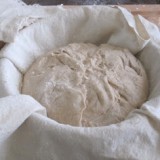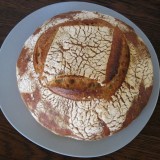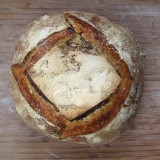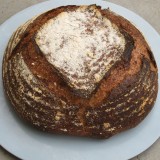 One of the tricks popularized by Jim Lahey’s no-knead bread recipe is using a Dutch oven to bake the bread. The Dutch oven harnesses the moisture in the dough to create a steamy environment. This allows the dough to rise rather than toast immediately. Commercial bread ovens (and some high-end home ovens) have steam injection systems that serve the same purpose. A Dutch oven is a lot cheaper, of course.
One of the tricks popularized by Jim Lahey’s no-knead bread recipe is using a Dutch oven to bake the bread. The Dutch oven harnesses the moisture in the dough to create a steamy environment. This allows the dough to rise rather than toast immediately. Commercial bread ovens (and some high-end home ovens) have steam injection systems that serve the same purpose. A Dutch oven is a lot cheaper, of course.
The trick is to get a loose and wet dough into a 500ºF Dutch oven without either burning yourself or smacking the loaf against the side of the pot. Some people first transfer the dough to parchment paper and then transfer that to the Dutch oven, (See Eric of GardenforkTV explain this method). Two years ago I finally broke down and bought a Lodge Combo cooker:
 To bake bread in it, you use it upside-down. The dough goes into the frying pan part and the pot goes on top. In order to get an evenly baked crust in our old oven I’ve got to turn the pot periodically in the last part of the bake. And that’s the problem. The handles make that difficult. It’s not a big deal (I can twist the loaf in the pot), but I’ve concluded that I would have been better off buying the Lodge casserole pot pictured at the top of this post since there’s no long handles.
To bake bread in it, you use it upside-down. The dough goes into the frying pan part and the pot goes on top. In order to get an evenly baked crust in our old oven I’ve got to turn the pot periodically in the last part of the bake. And that’s the problem. The handles make that difficult. It’s not a big deal (I can twist the loaf in the pot), but I’ve concluded that I would have been better off buying the Lodge casserole pot pictured at the top of this post since there’s no long handles.
Incidentally, trying to steam a home oven by spraying the inside with water or throwing in a wet towel does not work as well, in my opinion, since a lot of that moisture is lost out the vent.




In addition to baking with the dutch ovens and cast ironware, I have had decent success using Josey Baker’s approach. For bakers who already have a pizza stone he recommends just covering the dough with a stainless steel bowl or any other oven safe cover that can handle the heat and size of the loaf.
I’ve had an easier time transferring boules from a pizza peel onto the stone than into the cast iron pan. Mainly it seems easier because there isn’t a lip that you are trying to work with, you can just slide it onto the stone. All the options take some practice though as I have unfortunately degassed several loaves while transferring or sometime right after while trying to score the loaf before putting it in the oven.
Thankfully they all end up tasting pretty good!
Absolutely! I have a heavy ceramic tagine. I am able to load the bread into that without burning my wrists and even to slash the top before placing the lid on.
I have been singing the praises of the tagine without much success. …tho I suppose it’s not what you’d purchase specifically for bread. I was just gifted it and, tho it’s great for a braise, I use it much more for bread.
Hello
not to hijack you post, but do you have any suggestions on how to clean cast iron without using paper towels? We use recycled cloths for rags and try to create as little waste as possible. While I love cooking with cast iron, the best way to clean it is using paper towels. We’ve tried using newspaper but it is not super absorbent. Any suggestions on alternatives?
Have you looked into this? http://www.amazon.com/gp/product/B00FKBR1ZG/ref=as_li_tl?ie=UTF8&camp=1789&creative=390957&creativeASIN=B00FKBR1ZG&linkCode=as2&tag=nortediblife-20&linkId=5M4OZAYUXGO7PWJ6
Chainmail scrubber for cast iron – reusable, durable, won’t ruin the pan’s season and will get the crud out of the pan.
I’m a loyal dutch oven gal! I just put it in with parchment— it says there is a temperature limit, but the parchment inside the dutch oven is fine, and the parchment on the outside simply browns a bit. I just take the lid off towards the end to get a fantastic crust. Aaand now I need to make some homemade bread.
I use the combo cooker, but have never felt the need to use it upside down for bread. I find it easy to take the lid off partway through the bake, and lift the bread out with the sling of parchment paper when it is done. Does cooking upside down do anything to the final loaf, or is it just a matter of convenience?
PS: I’m playing around with a new lodge loaf pan for bread. Seems to work well, and I use an tin foil tent as a cover.